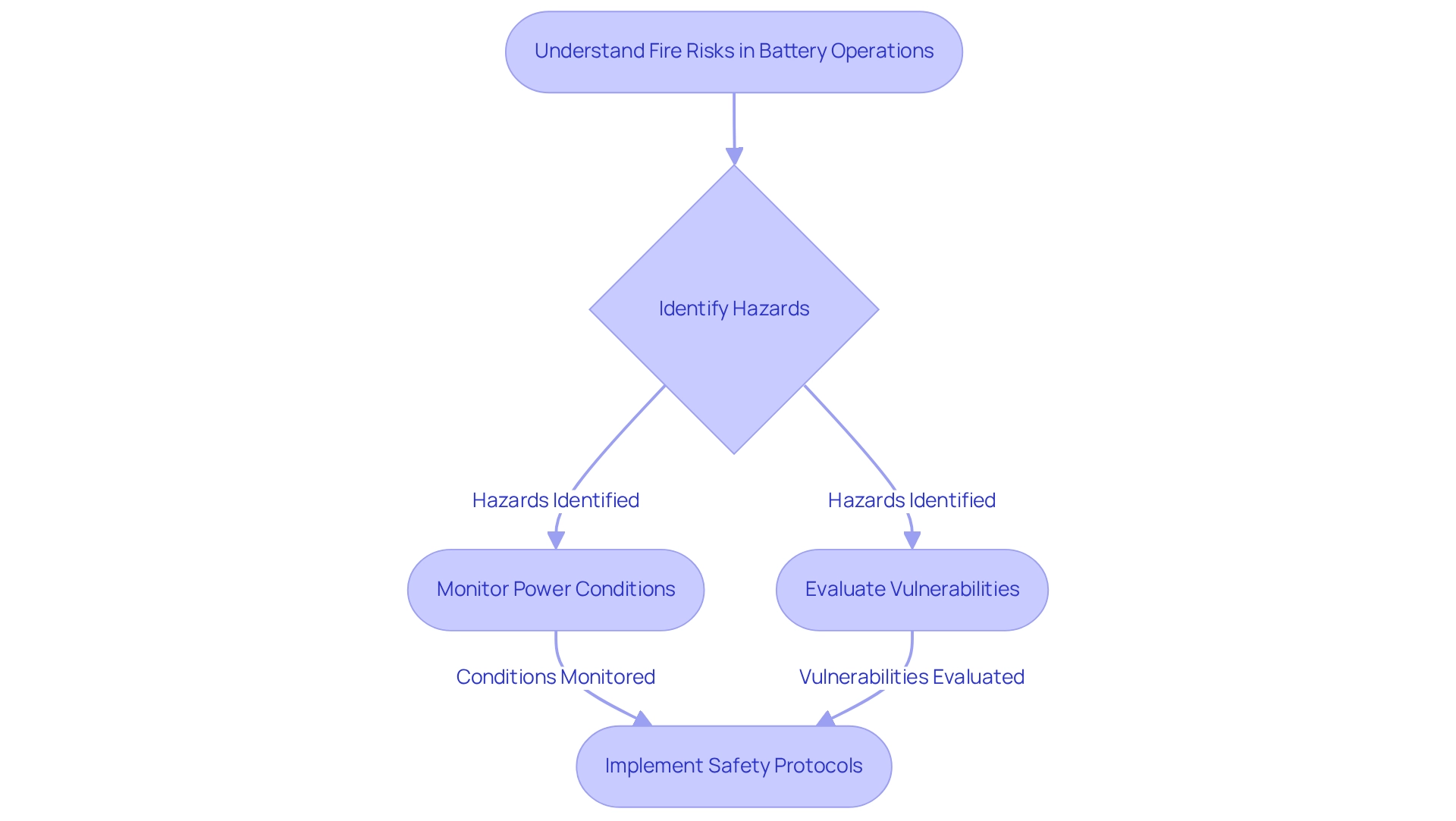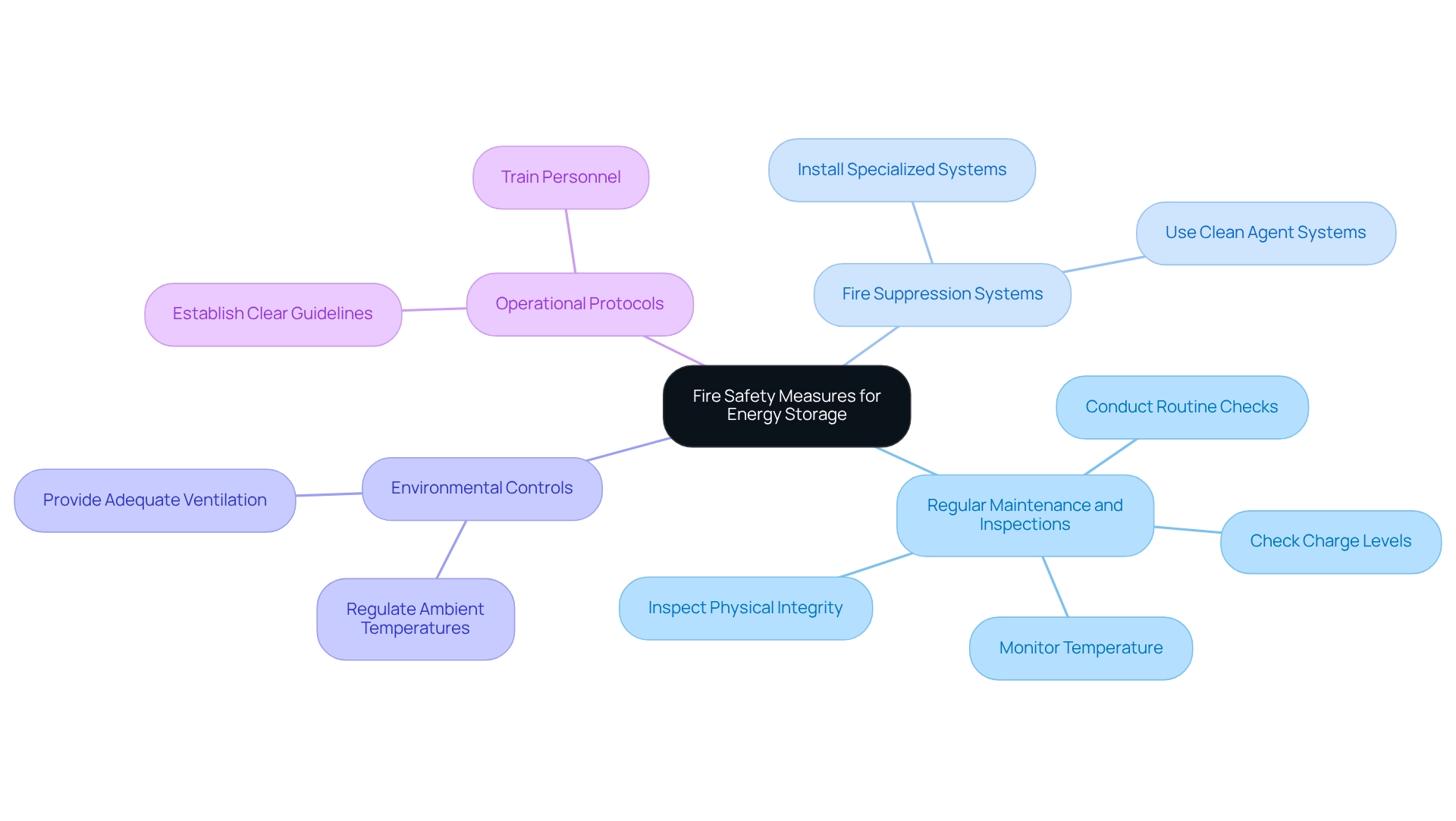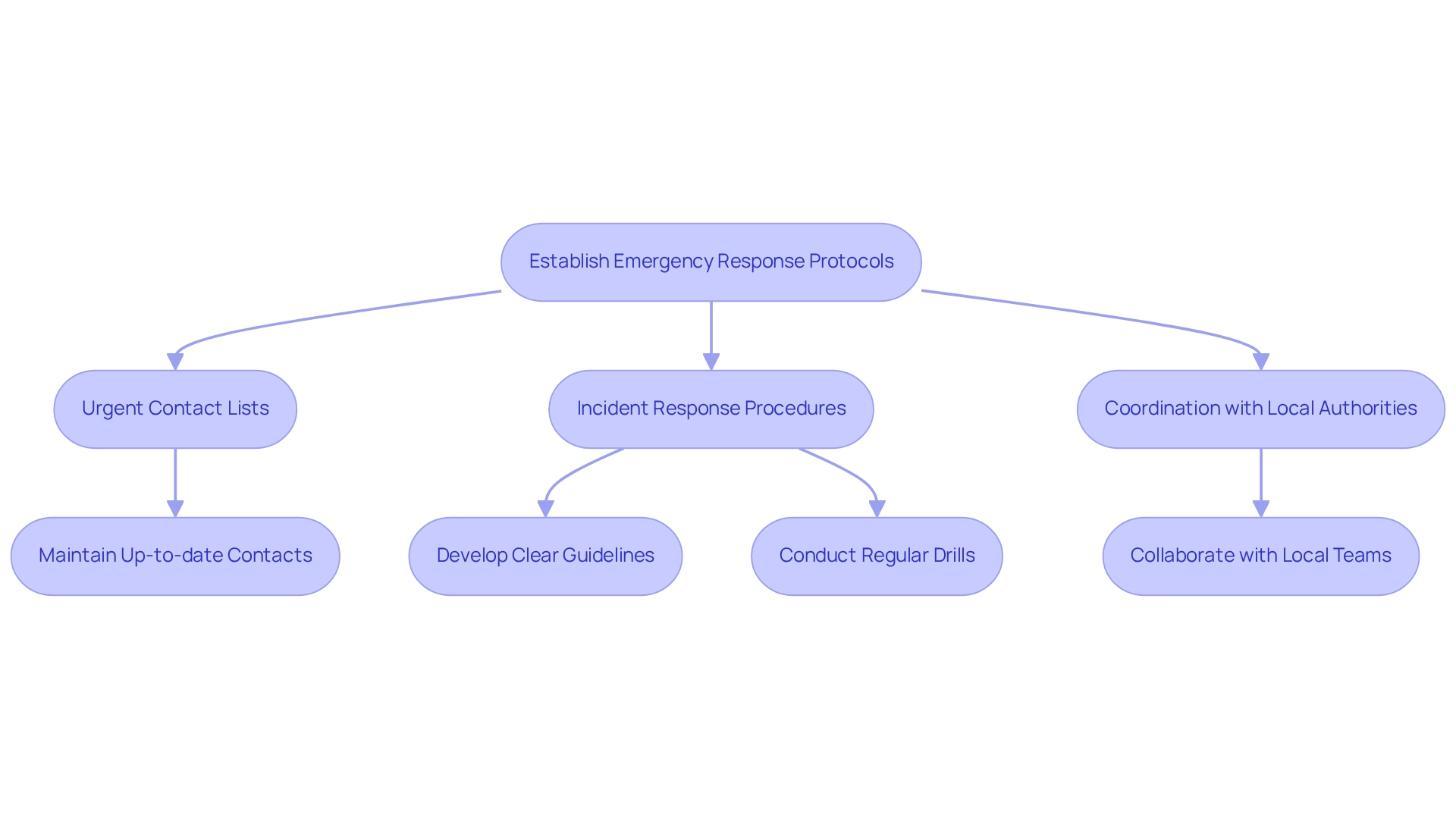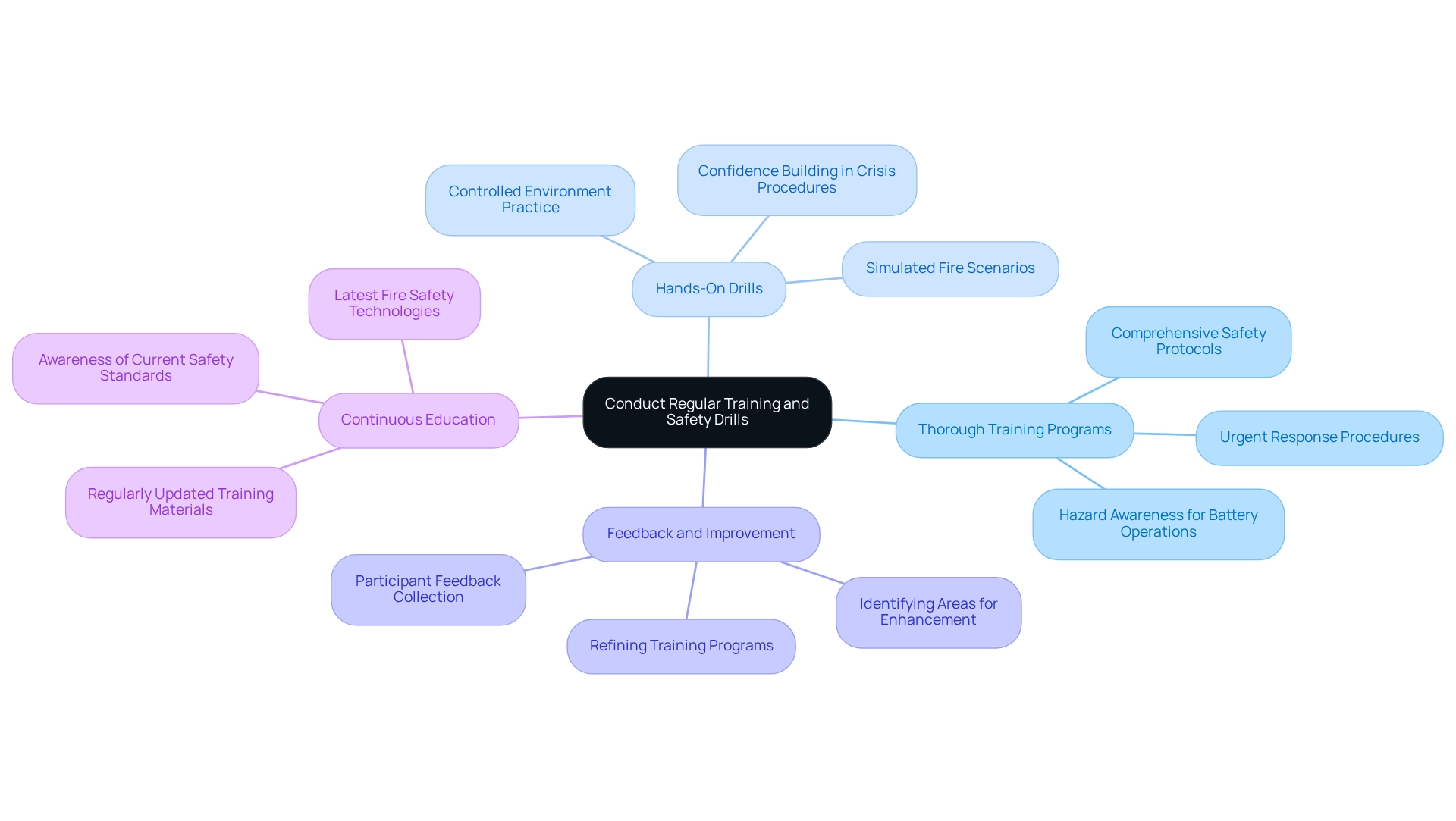Overview
Mitigating fire risks at battery sites is imperative for ensuring safety and operational integrity. Essential strategies include:
- Regular maintenance
- The installation of fire suppression systems
- The establishment of robust emergency response protocols
These measures are critical in addressing hazards such as thermal runaway, which pose significant threats to personnel and assets in energy storage operations. Furthermore, comprehensive training and safety drills enhance preparedness, reinforcing the importance of a proactive approach to risk management. By implementing these strategies, organizations can safeguard their operations and promote a culture of safety within the energy sector.
Introduction
The rise of lithium-ion technology has revolutionized battery operations; however, it has also introduced significant fire risks that demand urgent attention. The perilous phenomenon of thermal runaway, coupled with complications arising from environmental factors, underscores the critical need for understanding these hazards among organizations involved in battery management. As incidents continue to highlight the importance of safety in this field, it becomes imperative for stakeholders to implement robust preventive measures and establish comprehensive emergency response protocols. By prioritizing training and regular drills, organizations can cultivate a culture of safety that not only protects personnel but also safeguards valuable assets in an increasingly electrified world.
Understand Fire Risks in Battery Operations
Battery operations, particularly those utilizing lithium-ion technology, present significant hazards due to their chemical composition and operational characteristics. A major concern in fire risk mitigation for battery sites is thermal runaway, which can lead to fires and explosions if cells are damaged or improperly managed. Factors such as elevated temperatures, overcharging, and physical damage can exacerbate these risks.
It is crucial for stakeholders to understand these hazards to formulate comprehensive safety protocols. Recent incidents have highlighted the importance of monitoring power source conditions and implementing stringent operational guidelines as part of fire risk mitigation for battery sites. Organizations must conduct thorough evaluations to identify specific vulnerabilities within their energy storage systems and operations, ensuring that all personnel are informed of these threats and the necessary precautions to take.

Implement Preventive Measures for Fire Safety
To effectively mitigate hazards in energy storage operations, organizations must focus on fire risk mitigation for battery sites by implementing a range of preventive measures. This approach not only safeguards assets but also enhances operational safety.
Regular Maintenance and Inspections: Conduct routine checks on energy storage systems to identify and rectify potential issues before they escalate into failures. Monitoring temperature, charge levels, and physical integrity is crucial in this regard.
Installation of Fire Suppression Systems: Employ specialized fire suppression systems tailored for lithium-ion cells. Clean agent systems, for instance, can swiftly extinguish fires without causing damage to equipment, thereby protecting investments.
Environmental Controls: Ensure optimal operating conditions by regulating ambient temperatures and providing adequate ventilation in storage areas for energy cells. This practice helps prevent overheating and significantly reduces the risk of thermal runaway.
Clear Operational Protocols: Establish and enforce explicit operational guidelines for the handling, charging, and storage of energy cells. It is vital that all personnel receive training on these protocols as part of fire risk mitigation for battery sites to minimize the potential for human error. By adopting these comprehensive measures, organizations can dramatically decrease the likelihood of incidents and bolster overall safety in energy storage operations.

Establish Emergency Response Protocols
Creating robust crisis response procedures is essential for fire risk mitigation for battery sites in effectively managing combustion incidents. An effective emergency response plan for fire risk mitigation for battery sites comprises several key components:
- Urgent Contact Lists: Maintain up-to-date lists of urgent contacts, including local safety services, hazardous materials teams, and internal safety personnel.
- Incident Response Procedures: Develop clear guidelines for fire risk mitigation for battery sites, including evacuation routes, extinguishing techniques, and communication protocols. It is crucial that all employees are well-acquainted with these procedures, particularly those related to fire risk mitigation for battery sites: conduct regular drills to ensure that all staff are prepared to respond efficiently in the event of a fire. Simulations can reveal gaps in the response plan and enhance overall readiness.
- Coordination with Local Authorities: Collaborate with local rescue teams and response services to familiarize them with the facility and its specific hazards. This collaboration can significantly improve response times and effectiveness during an incident, especially regarding fire risk mitigation for battery sites. By implementing these protocols, organizations can ensure a swift and effective response to emergency incidents, thereby minimizing potential harm to personnel and property.

Conduct Regular Training and Safety Drills
Carrying out frequent training and safety exercises is essential for ensuring that all staff are prepared to manage crisis situations efficiently. This commitment not only enhances readiness but also fosters a culture of safety within the organization. Key strategies include:
-
Thorough Training Programs: Develop comprehensive training programs that address safety protocols, urgent response procedures, and the specific hazards related to battery operations to support fire risk mitigation for battery sites. Such training should be mandatory for all employees, including new hires, to ensure uniform preparedness.
-
Hands-On Drills: Implement practical drills that simulate fire scenarios, allowing employees to practice their responses in a controlled environment. These exercises strengthen training and bolster confidence in crisis procedures.
-
Feedback and Improvement: After each drill, gather participant feedback to identify areas for enhancement. Utilize this information to refine training programs and emergency response plans, ensuring continuous improvement.
-
Continuous Education: Stay abreast of the latest fire safety technologies and best practices. Regularly refreshing training materials to incorporate new information is crucial for fire risk mitigation for battery sites, ensuring that all personnel are aware of current safety standards. By prioritizing training and drills, organizations can significantly reduce the risks associated with battery operations, ultimately safeguarding their workforce and assets.

Conclusion
The inherent fire risks associated with lithium-ion battery operations demand a comprehensive understanding and proactive management approach. Key hazards, such as thermal runaway, can lead to catastrophic incidents if not properly addressed. Organizations must prioritize the identification of these risks and implement robust safety protocols, including:
- Regular maintenance
- Fire suppression systems
- Environmental controls
By doing so, they can significantly reduce the likelihood of fire incidents and protect both personnel and assets.
Establishing well-defined emergency response protocols further enhances safety in battery operations. Effective plans must include:
- Clear incident response procedures
- Regular drills
- Coordination with local emergency services
to ensure a swift response to any fire incidents. This preparation is crucial for mitigating the impact of emergencies and safeguarding lives.
Moreover, ongoing training and safety drills are vital for cultivating a culture of preparedness within organizations. Comprehensive training programs and hands-on simulations equip personnel with the knowledge and skills needed to respond effectively to fire emergencies. Continuous education on the latest safety technologies and practices ensures that all employees remain informed and ready to act.
In an increasingly electrified world, prioritizing fire safety in battery operations is not merely a regulatory obligation but a moral imperative. By fostering a proactive safety culture, organizations can navigate the challenges posed by lithium-ion technology while protecting their most valuable assets—their people and their environment.
Frequently Asked Questions
What are the main hazards associated with battery operations using lithium-ion technology?
The main hazards include risks of thermal runaway, which can lead to fires and explosions if cells are damaged or improperly managed, as well as risks from elevated temperatures, overcharging, and physical damage.
What is thermal runaway in the context of battery operations?
Thermal runaway is a condition where a battery cell overheats and can result in fires or explosions, often triggered by damage, improper management, or specific operational conditions.
What measures should stakeholders take to mitigate fire risks at battery sites?
Stakeholders should understand the hazards, monitor power source conditions, implement stringent operational guidelines, and conduct thorough evaluations to identify vulnerabilities in their energy storage systems.
Why is it important for organizations to evaluate their energy storage systems?
It is important to identify specific vulnerabilities and ensure that all personnel are informed of potential threats and the necessary precautions to take for safety.
How can recent incidents inform safety protocols for battery operations?
Recent incidents highlight the critical need for monitoring and implementing comprehensive safety protocols to mitigate fire risks effectively.




